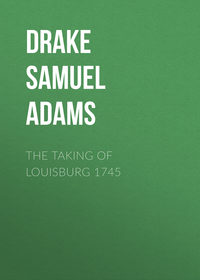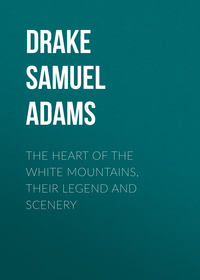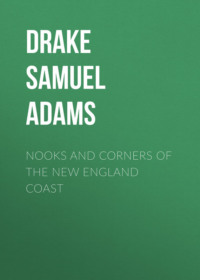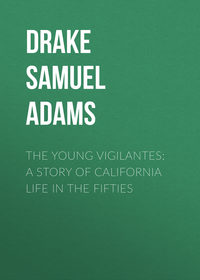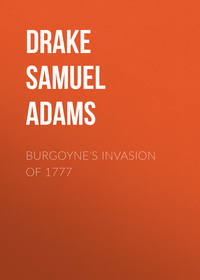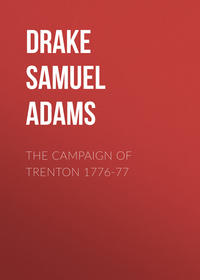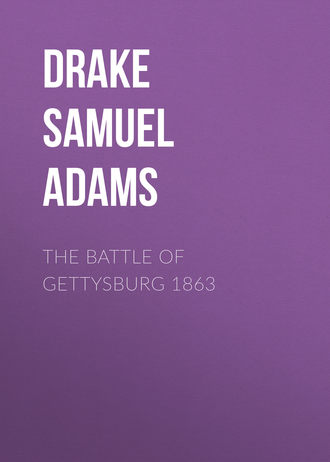 полная версия
полная версияThe Battle of Gettysburg 1863

Samuel Adams Drake
The Battle of Gettysburg 1863
I
Gettysburg 1
The Town.
Stripped of the glamour which has made its every stick and stone an object of eager curiosity or pious veneration, Gettysburg becomes a very plain, matter-of-fact Pennsylvania town, of no particular antiquity, with a very decided Dutch flavor in the names and on the tongues of its citizens, where no great man has ever flourished, or anything had happened to cause its own name to be noised abroad, until one day in the eventful year 1863 – the battle year – fame was suddenly thrust upon it, as one might say, not for a day, but for all time. The dead who sleep in the National Cemetery2 here, or who lie in unknown graves about the fields and woods, and counting many times more than the living, help us to understand how much greater was the battle of Gettysburg than the town which has given it its name.
Gettysburg is the market town – or borough, accurately speaking – of an exclusively farming population, planted in one of the most productive sections of the Keystone State. It is the seat of justice of the county. It has a seminary and college of the German Lutheran Church, which give a certain tone and cast to its social life. In short, Gettysburg seems in all things so entirely devoted to the pursuits of peace, there is so little that is suggestive of war and bloodshed, even if time had not mostly effaced all traces of that gigantic struggle,3 that, coming as we do with one absorbing idea in mind, we find it hard to reconcile the facts of history with the facts as we find them.
The Landscape.
There is another side to Gettysburg – a picturesque, a captivating side. One looks around upon the landscape with simple admiration. One's highest praise comes from the feeling of quiet satisfaction with which the harmony of nature reveals the harmony of God. You are among the subsiding swells that the South Mountain has sent rippling off to the east. So completely is the village hid away among these green swells that neither spire nor steeple is seen until, upon turning one of the numerous low ridges by which the face of the country is so cut up, you enter a valley, not deep, but well defined by two opposite ranges of heights, and Gettysburg lies gleaming in the declining sun before you – a picture to be long remembered.
Its situation is charming. Here and there a bald ridge or wooded hill, the name of which you do not yet know, is pushed or bristles up above the undulating prairie-land, but there is not one really harsh feature in the landscape. In full view off to the northwest, but softened by the gauzy haze of a midsummer's afternoon, the towering bulk of the South Mountain, vanguard of the serried chain behind it, looms imposingly up between Gettysburg and the Cumberland Valley, still beyond, in the west, as landmark for all the country round, as well as for the great battlefield now spreading out its long leagues before you; a monument more aged than the Pyramids, which Napoleon, a supremely imaginative and magnetic man himself, sought to invest with a human quality in the minds of his veterans, when he said to them, "Soldiers! from the summits of yonder Pyramids forty ages behold you." In short, the whole scene is one of such quiet pastoral beauty, the village itself with its circlet of fields and farms so free from every hint of strife and carnage, that again and again we ask ourselves if it can be true that one of the greatest conflicts of modern times was lost and won here.
Yet this, and this alone, is what has caused Gettysburg, the obscure country village, to be inscribed on the same scroll with Blenheim, and Waterloo, and Saratoga, as a decisive factor in the history of the nations. Great deeds have lifted it to monumental proportions. As Abraham Lincoln so beautifully said when dedicating the National Cemetery here, "The brave men, living and dead, who struggled here have consecrated it far above our power to add or detract. The world will little note, nor long remember, what we say here, but it can never forget what they did here."
Those noble words ought to be the guiding inspiration of every one who intends adding his own feeble impressions of this great battle to what has been said before.
Strategic Importance.
Playing at Blind-Man's-Buff.
The strategic importance that Gettysburg suddenly assumed during Lee's invasion of Pennsylvania, in July, 1863, first demands a little of our attention. Yet it seems certain that neither Meade nor Lee had thought of it as a possible battle-ground until accident thrust it upon them. At his first setting out on this campaign Lee had not been able to say, with the map before him, "I will fight a battle either in this or that place," because he had marched not toward, but away from, his adversary, and, so far as can be known, without choosing beforehand a position where Meade would have to come and attack him. For his part, so long as Meade was only following Lee about, the Union general cannot be said to have had much voice in the matter. It was Lee who was really directing Meade's march. True enough, Meade did select a battlefield, but not here, at Gettysburg; nor do we know, nor would it be useful to inquire, whether Lee could have been induced to fight just where Meade wanted him to. As Lee fought at Gettysburg only because he was struck, it is probably beyond any man's power to say that if this had not happened, as it did, Lee would have marched on toward Baltimore, knowing that Meade's army lay intrenched in his path. There is a homely maxim running to the effect that you can lead a horse to water, but cannot make him drink. The two generals, therefore, merely launched their columns out hit or miss, like men playing at blind-man's-buff.
Gettysburg lies at the apex of a triangle of which Harrisburg and Baltimore form the base angles, at north and south – Harrisburg being only thirty-six and Baltimore about fifty miles distant. York and Carlisle also lie either on or so near this triangle as to come within its scope as a basis for military operations. Placed at Gettysburg, an army threatened all of these points.

Diagram showing strategic value of Gettysburg. H., Harrisburg; G., Gettysburg; P., Philadelphia; Y., York; B., Baltimore; W., Washington.
Topographical Features.
Baltimore and Taneytown Roads.
Cemetery Hill.
From a military point of view there are but two features about Gettysburg on which the eye would long rest. These are the two ridges, with a broad valley between, heaved up at east and west and running off south of the town. They stand about a mile apart, though the distance is sometimes less than that. As it nears Gettysburg the easternmost ridge glides down, by a gentle slope, into what may be called a plain, in comparison with the upheavals around it, although it is by no means a dead level. Yet it is open because the ridges themselves have stopped short here, forming headlands, so to speak, above the lower swells. On coming down off this ridge the descent is seen to be quite easy – in fact, two roads ascend it by so gradual a rise that the notion of its being either high or steep is quite lost, and you are ready to discard off-hand any preconceived notion about its being a natural stronghold. It is mostly on this slope that Gettysburg is built, its houses extending well up toward the brow, and its cemetery occupying the brow itself. Hence, although the centre of Gettysburg may be three-fourths of a mile from the cemetery gate, the town site is in fact but a lower swell of the historic ridge which has since taken the name of its graveyard – Cemetery Ridge.
Seminary Ridge.
Across this valley, again, the western ridge, which looks highest from the town, has what Cemetery Hill has not, namely, a thin fringe of trees skirting its entire crest, thus effectually masking the view in that direction; and it is further distinguished by the cupola of the Lutheran Seminary,4 seen rising above trees at a point opposite the town, and giving its name to this ridge – Seminary Ridge. Both ranges of heights are quite level at the top, and easily traversed; so also the slopes of both are everywhere easy of ascent, the ground between undulating, but nowhere, except far down the valley, badly cut up by ravines or watercourses. Indeed, better ground for a fair stand-up fight it would be hard to find; for all between the two ridges is so clear and open that neither army could stir out toward its opponent without being detected at once – the extreme southern part of the valley excepted. In this respect I take the liberty of observing that the actual state of things proved very different from that conveyed in some of the published accounts, wherein Cemetery Ridge is represented as a sort of Gibraltar.
A very brief survey, however, suggests that an army could be perfectly hid behind the trees of Seminary Ridge, as well as better sheltered from artillery fire, while one stretched out along the bare and treeless summit of Cemetery Ridge would be without such screen or protection.
The description must be a little farther pursued, if the battle is to be at all intelligently followed.
Enough for the two main ridges enclosing Gettysburg and its valley. We come now to that most striking feature of the landscape, notably on the side of Cemetery Ridge, but more or less characteristic of both sides of the valley. This is the group of hills standing off from Cemetery Ridge at either end, just as if, at some remote time, this ridge had formed a continuous chain, the summits of which had been cleanly shaved off at the centre, leaving these isolated clusters to show where the wasting forces had passed. From different points of view we may see one or both of them rising above the ridge like giant watch-towers set at the extremities of some high embattled wall.
Culp's Hill.
Rock Creek.
Let us first take the northernmost cluster, formed of Wolf's, McAllister's, and Culp's hills. It is seen to be thrown back behind Cemetery Hill, to which Culp's Hill alone is slenderly attached by a low ridge, so making an elbow with it, or, in the military phrase, a refused line. Between Culp's Hill and Wolf's Hill flows Rock Creek, the shallow stream so often mentioned in connection with the battle, its course lying through a shaggy ravine.5 The ravine and stream of Rock Creek threw Wolf's Hill somewhat out of the true line of defence, but the merest novice in military art sees at a glance why the possession of Culp's Hill was all-essential to the security of Cemetery Hill, since there is little use in shutting the front door if the back door is to be left standing open.
The Round Tops.
The Devil's Den.
The same is just as true of the southernmost group, composed of Little and Great Round Tops, two exceedingly picturesque summits, standing up above the generally monotonous contours about them in strong relief. They also were wooded from base to summit, and they show, even more distinctly than the first group, where the crushing out or denuding forces have been at work, in shelves or crevices of broken ledge at the highest points, in ugly bowlders cropping out on the slopes, in miry gullies crawling at their feet, but most of all in the deformed heap of ripped-up ledges, topped with coppices and scattered trees, thrust out from Little Round Top and known as the Devil's Den.6
When it is added that the way is open between the two Round Tops to the rear of Cemetery Ridge, the importance of holding them firmly becomes self-evident; and inasmuch as the greatest natural strength of this ridge lay at its extremities, or flanks, so its weakness would result from a neglect to occupy those flanks.
The Swale.
This line was assailable at one other point. As it approaches Little Round Top the ridge sinks away to the general level around it, or so as to break its continuity, thus leaving a gap more or less inviting the approach of an enemy. The whole extent of this crooked line, at which we have just glanced, is about two and a half miles.
Emmettsburg Road.
Down below, in the valley, there is another swell of ground, hardly worth dignifying by the name of ridge, yet assuming a certain importance, nevertheless, first because it starts from the town close under Cemetery Hill, thence crossing the valley diagonally till it becomes merged in Seminary Ridge, at a point nearly opposite to the Round Tops, and next because the Emmettsburg road runs on it. In brief, its relation to the battle was this: it ran from the Union right into the Confederate right, so traversing the entire front of both armies. It had an important part to play in the second day's battle, as we shall soon see, for, though occupying three days, Gettysburg was but a series of combats in which neither army employed its whole force at any one time.
II
THE MARCH INTO PENNSYLVANIA
Lee in Maryland.
It is in no way essential to relate in detail how Lee's army, slipping away from ours on the Rappahannock,7 and after brushing out of its path our troops posted in the Shenandoah Valley, had been crossing the Potomac into Maryland since the 21st of June, by way of the Cumberland Valley, without firing a shot.8
His Bold Strategy.
A very unusual thing in war it is to see an army which has just been acting strictly on the defensive suddenly elude its adversary for the purpose of carrying the war into that enemy's country! It marks a new epoch in the history of that war, and it supposes wholly altered conditions. In this particular instance Lee's moves were so bold as almost to savor of contempt.
It is enough to know that Lee was now in Pennsylvania, at the head of seventy thousand men, before our army reached the Potomac in pursuit of him, if following at a respectful distance be called a pursuit.
State of his Army.
At no period of the war, their own officers said, had the Confederates been so well equipped, so well clothed, so eager for a fight, or so confident of success; and we may add our own conclusions, that never before had this army taken the field so strong in numbers, or with such a powerful artillery.9
Superiority as Marksmen.
The infantry were armed with Enfield rifles, fresh from British workshops, and it is probable that no equal number of men ever knew how to use them better. Indeed, we consider it indisputable that the Confederates greatly excelled the Union soldiers as marksmen. Most of them were accustomed to the use of firearms from boyhood; in some sections they were noted for their skill with the rifle. The Confederates, therefore, were nearly always good shots before they went into the army, while the Union soldiers mostly had to acquire what skill they could after going into the ranks. In the South the habit of carrying arms was almost universal: in the North it was not only unusual, but unpopular as well as unlawful.
Superiority in Cavalry.
Man for man, the Confederate cavalry was also superior to the Union horse, because in one section riding is a custom, in the other a pastime rarely indulged in. Consequently, it took months to teach a Union cavalryman how to ride, – a costly experiment when your adversary is already prepared, – whereas if there is anything a Southerner piques himself upon, it is his horsemanship.10
Cavalry Advance.
Cumberland Valley raided.
Lee's cavalry had preceded the infantry by nearly a week, reaching Chambersburg on the 16th, seizing horses and provisions for the use of the army behind them, and spreading consternation to the gates of Harrisburg itself. Having loaded themselves with plunder unopposed, they then fell back upon the main army, thus leaving it in some doubt whether this raid accomplished all it designed, or was only the prelude to something for which it was serving as a mask.11
Ewell at Chambersburg.
Hood's Soldiers.
All doubts were set at rest, however, when, on the 23d, Ewell's dust-begrimed infantry came tramping into Chambersburg, regiment after regiment, hour after hour, until the streets fairly swarmed with them. Though the houses were shut up, a few citizens were in the streets, or looking out of their windows at the passing show, as men might at the gathering of a storm-cloud about to burst with destructive fury upon them; and though the time was hardly one for merriment, we are assured that some of these lookers-on could not refrain from "pointing and laughing at Hood's ragged Jacks" as they marched along to the tune of "Dixie's Land." "This division," remarks the partial narrator, "well known for its fighting qualities, is composed of Texans, Alabamians, and Arkansians, and they certainly are a queer lot to look at. They carry less than any other troops; many of them have only got an old piece of carpet or rug as baggage; many have discarded their shoes in the mud; all are ragged and dirty, but full of good-humor and confidence in themselves and their general.12 They answered the numerous taunts of the Chambersburg ladies with cheers and laughter." To the scowling citizens the Confederates would call out from the ranks, "Well, Yank, how far to Harrisburg? How far to Baltimore? What's the charge at the Continental?" or some such innocuous bits of irony as came into heads turned, no doubt, at the thought of standing unchallenged on Northern soil, where nothing but themselves recalled war or its terrors, or at sight of the many evidences of comfort and thrift to which they themselves were strangers. But we shall meet these exultant ragamuffins ere long under far different circumstances.
This was Lee's corps of observation, destined to do most of the hard marching and fighting which usually falls to the lot of the cavalry, as it was mostly composed of old, well-seasoned soldiers, who had been accustomed, under the lead of Jackson, to win their victories largely with their legs. Part marched through the town, and went into camp on the Carlisle road, part occupied the pike leading toward Gettysburg; sentries were posted in the streets, a military commandant was appointed, and for the time being Chambersburg fell wholly under rebel rule, which, so long as it remained the army headquarters, we are bound to say does not appear to have been more onerous than circumstances would warrant.
Main Army comes up.
Ewell's corps was followed, at one day's march, by the main body, comprising Hill's and Longstreet's corps, with whom marched Lee himself, the man on whom all eyes, North and South, were now turned.
Ewell to Carlisle.
Early to York.
As soon as the main body had come up Ewell moved straight on toward Carlisle and Harrisburg with two divisions, while his third turned off to the east, toward York, with the view of drawing attention away from the main object by seeming to threaten Baltimore or Philadelphia.13 It was to strike the Susquehanna at Columbia, and get possession of the railway bridge there, as a means of passing over to the north side of that river to Harrisburg.
Early at Gettysburg.
This division (Early's) passed through Gettysburg on the 26th,14 reaching York the next day. On the 28th his advance arrived at the Susquehanna too late to save the railway bridge from the flames.15 On this same day Ewell's advance encamped within four miles of Harrisburg, where some skirmishing took place.
Region seized by Lee.
Here, then, was Lee firmly installed within striking distance of the capital of the great Keystone State, and by no means at so great a distance from Philadelphia or Washington as not to make his presence felt in both cities at once.
If he had not come prepared to fight every soldier that the Federal government could bring against him – to fight even against odds – what was he doing here in the heart of Pennsylvania?
Spirit of his Army.
The army which followed Lee into Pennsylvania was brave and devoted – none more so. It looked up to him with a species of adoration, born of an abiding faith in his genius. Reasoning from experience, the belief that it would continue to beat the Union army was not unfounded. At any rate, it was universal. Thus led, and imbued with such a spirit, no wonder the Confederate army considered itself invincible.
Thus followed, Lee, or Uncle Robert, as he was familiarly called by his soldiers, though no man could be more aristocratic in his tastes or manners, was accustomed to exact greater efforts from them, both in marching and fighting, than the Union generals ordinarily could from their better-fed, better-clothed, and better-disciplined troops.
Lee's Portrait.
A pen portrait of General Lee himself, as he appeared at this time, seems necessary to the historical completeness of this sketch. It is drawn by a British colonel,16 on leave with Lee's army, where he found himself quite at home. He says: "General Lee is, almost without exception, the handsomest man of his age I ever saw. He is fifty-six years old, tall, broad-shouldered, very well made, well set up – a thorough soldier in appearance; and his manners are courteous and full of dignity. He generally wears a well-worn long gray jacket, a high black felt hat, and blue trousers tucked into his Wellington boots. I never saw him carry arms, and the only marks of military rank are the three stars on his collar. He rides a handsome horse which is extremely well groomed. He himself is very neat in his dress and person, and in the most arduous marches, as after the retreat from Gettysburg, when everybody else looked and was extremely dirty, he always looked smart and clean."

Positions, June 28th.
In an order commending the behavior of his men while on the march, Lee called attention to certain excesses which he declared his intention of repressing in a summary manner.
The region to which the Confederate operations were now confined is indicated by the accompanying map. It will be seen that Lee had not hesitated to scatter his army considerably.
Leaving Ewell before Harrisburg, Early at York, and Lee himself at Chambersburg, we will look first at the state of feeling brought about by this daring invasion, which had been urged from Richmond on the theory that the road to peace lay through Pennsylvania, via Washington.
III
FIRST EFFECTS OF THE INVASION
Meantime, from before and behind the Confederate columns, two streams flowed out of the doomed valley: one to the north, an army of fugitives hurrying their flocks, herds, and household goods out of the enemy's reach; the other carrying off to Virginia the plunder of towns and villages.
Harrisburg alarmed.
As the swarm of fugitives made straight for Harrisburg, it was but natural that the inpouring of such panic-stricken throngs, all declaring that the enemy was close behind them, should throw that city into the wildest commotion, which every hour tended to increase. We will let an eye-witness describe the events of a single day.
"The morning broke upon a populace all astir, who had been called out of bed by the beat of the alarming drum, the blast of the bugle, and the clanging of bells. The streets were lively with men, who were either returning from a night's work on the fortifications or going over to relieve those who were toiling there. As the sun rose higher the excitement gathered head. All along the streets were omnibuses, wagons, and wheelbarrows, taking in trunks and valuables and rushing them down to the dépôt to be shipped out of rebel range. The stores, the female seminaries, and almost every private residence were busy all of the forenoon in swelling the mountain of freight that lay at the dépôt. Every horse was impressed into service and every porter groaned beneath his burdens.
People desert the City.
"The scene at the dépôts was indescribable, if not disgraceful. A sweltering mass of humanity thronged the platforms, all furious to escape from the doomed city. At the bridge and across the river the scene was equally exciting. All through the day a steady stream of people, on foot and in wagons, young and old, black and white, was pouring across it from the Cumberland Valley, bearing with them their household goods and live-stock. Endless trains, laden with flour, grain, and merchandise, hourly emerged from the valley and thundered across the bridge and through the city. Miles of retreating baggage-wagons, filled with calves and sheep tied together, and great, old-fashioned furnace-wagons loaded with tons of trunks and boxes, defiled in continuous procession down the 'pike and across the river, raising a dust as far as the eye could see."





